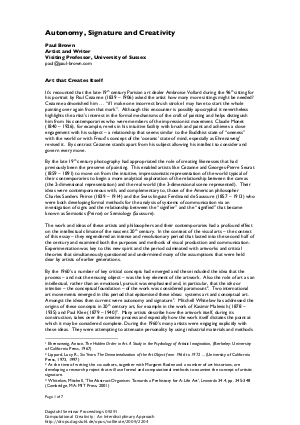Autonomy, Signature and Creativity
Author Paul Brown
-
Part of:
Volume:
Dagstuhl Seminar Proceedings, Volume 9291
Part of: Series: Dagstuhl Seminar Proceedings (DagSemProc) - License:
 Creative Commons Attribution 4.0 International license
Creative Commons Attribution 4.0 International license
- Publication Date: 2009-10-07
File

PDF
DagSemProc.09291.7.pdf
- Filesize: 449 kB
- 7 pages
Document Identifiers
Subject Classification
Keywords
- Computational creativity
- autonomous art
- signature
Metrics
- Access Statistics
-
Total Accesses (updated on a weekly basis)
0Document
0Metadata
Abstract
One of the key themes that emerged from the formal investigations of art and aesthetics during the 20th century was that of the autonomous artwork. The goal of an artwork that was not just self-referential but also self-creating found renewed vigour in the work of the systems and conceptual artists and especially those who were early adopters of the then-new technology of artificial intelligence (AI). A key problem is that of signature: at what point can we claim that an artwork has its own distinct signature? My own work in this area began in the 1960’s with an early, and in retrospect, naive assumption. At that time art was still based on the concept of engagement with the materiality of the medium. I suggested that using a symbolic language to initiate a process would distance me far enough from the output of that process for it to have the potential of developing its own intrinsic qualities including a unique signature. By the 1990s it had become obvious that this approach had failed. Complementary research in many fields had demonstrated that the signatures of life were robust and strongly relativistic. The myriad bonds that define a signature are embedded in even the simplest symbol system and any attempt to create autonomy by formal construction is unlikely to succeed. During this same period a group of biologically inspired computational methods were revisited after several decades of neglect; evolutionary, adaptive and learning systems suggested a “bottom up” approach to the problem. If it’s not possible to design an autonomous agency then can we instead make a system that evolves, learns for itself and eventually has the potential of displaying autonomy as an emergent property? The DrawBots project is an attempt to apply these computational methods to the problem of artistic autonomy. It is an example of a strong art-science collaboration where all the disciplines involved have a significant investment in the project and its themes.
Cite As Get BibTex
Paul Brown. Autonomy, Signature and Creativity. In Computational Creativity: An Interdisciplinary Approach. Dagstuhl Seminar Proceedings, Volume 9291, pp. 1-7, Schloss Dagstuhl – Leibniz-Zentrum für Informatik (2009)
https://doi.org/10.4230/DagSemProc.09291.7
BibTex
@InProceedings{brown:DagSemProc.09291.7,
author = {Brown, Paul},
title = {{Autonomy, Signature and Creativity}},
booktitle = {Computational Creativity: An Interdisciplinary Approach},
pages = {1--7},
series = {Dagstuhl Seminar Proceedings (DagSemProc)},
ISSN = {1862-4405},
year = {2009},
volume = {9291},
editor = {Margaret Boden and Mark D'Inverno and Jon McCormack},
publisher = {Schloss Dagstuhl -- Leibniz-Zentrum f{\"u}r Informatik},
address = {Dagstuhl, Germany},
URL = {https://drops.dagstuhl.de/entities/document/10.4230/DagSemProc.09291.7},
URN = {urn:nbn:de:0030-drops-22047},
doi = {10.4230/DagSemProc.09291.7},
annote = {Keywords: Computational creativity, autonomous art, signature}
}
